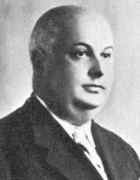Person: Fantappiè, Luigi

Luigi Fantappiè was an Italian mathematician who worked in mathematical analysis and created the theory of analytic functionals.
Mathematical Profile (Excerpt):
- His parents were Liberto Fantappiè and Agrippina Gnazza.
- He became a friend of Enrico Fermi who was almost exactly the same age (Fantappiè was exactly two weeks older than Fermi).
- Fantappiè graduated with a doctorate on 4 July 1922 having attained full marks in the pure mathematics examinations.
- His dissertation, supervised by Luigi Bianchi, was Le forme decomponibili coordinate alle classi di ideali nei corpi algebrici Ⓣ(Form of decomposable coordinates in the classes of ideals in algebraic fields).
- What Fantappiè did was take the theory which had been developed for analytical functions and generalise this theory to the case of functionals.
- This led to what Fantappiè called analytic functionals, and he developed this theory over almost twenty years through the 1920s and 1930s.
- Fantappiè's work on analytic functionals had led to him receiving a number of awards.
- In 1933 Fantappiè left Italy and went to the University of Sao Paulo in Brazil where he founded the Mathematics Department and was head of the new department from 1933 to 1939.
- Although Fantappiè continued to undertake research on analytic functionals, he began to study a new area in 1941.
- On 30 October 1942 Fantappiè presented his theory of syntropy to the Accademia d'Italia with a work entitled The Unified Theory of the Physical and Biological World (published in Spanish in 1943).
- There was another major idea introduced by Fantappiè, namely a cosmological theory based on a geometry arising from a group which, in some sense, generalises the Lorentz group.
- For example in Deduzione autonoma dell'equazione generalizzata di Schrödinger, nella teoria di relatività finale Ⓣ(Autonomous deductions from the generalized Schrödinger equation, in the final theory of relativity) (1955) Fantappiè deduces the Klein-Gordan equation in quantum mechanics as a limit, as the radius of the universe tends to infinity, of a classical (non-quantized) equation in his extension of relativity based on a simple (pseudo-orthogonal) group having the Lorentz group as a type of limit.
- Fantappiè was still working on this theory at the time of his death in 1956 at the age of only 54 years.
- Finally let us look briefly at some of the papers which Fantappiè published in the last seven years of his life: Costruzione effettiva di prodotti funzionali relativisticamente invarianti Ⓣ(Construction of relativistic invariant products of functions) (1949) constructs functional scalar products of two functions, as required in quantum mechanics, which are relativistically invariant; Caratterizzazione analitica delle grandezze della meccanica quantica Ⓣ(Analytical characterization of the quantum mechanical magnitudes) (1952) gives conditions on an hermitian operator that he claims are necessary and sufficient for it to satisfy to represent a physically real observable; Determinazione di tutte le grandezze fisiche possibili in un universo quantico Ⓣ(Determination of all possible physical quantities in a quantum universe) (1952) discusses aspects of group invariance of wave equations; Gli operatori funzionali vettoriali e tensoriali, covarianti rispetto a un gruppo qualunque Ⓣ(Vector functional operators and tensor, covariant with respect to any group) (1953) discusses the role of operators and Lie groups in a quantum-mechanical universe; Deduzione della legge di gravitazione di Newton dalle proprietà del gruppo di Galilei Ⓣ(Deduction of Newton's law of gravitation from properties of the Galileo group) (1955) shows that the inverse square law is a necessary consequence if certain specific assumptions are made; Les nouvelles méthodes d'intégration, en termes finis, des équations aux dérivées partielles Ⓣ(New integration methods, in finite terms of partial differential equations) (1955) applies analytic functionals to find explicit solutions of partial differential equations; and Sur les méthodes nouvelles d'intégration des équations aux dérivées partielles au moyen des fonctionnelles analytiques Ⓣ(On new methods of integration of partial differential equations using analytical functionals) (1956) gives a new method for the solution of Cauchy's problem.
- To honour Fantappiè, a congress entitled Frontiers of Biology and Contemporary Physics was held in his home town of Viterbo from 13 to 16 August 2009.
Born 15 September 1901, Viterbo, Italy. Died 28 July 1956, Bagnaia, near Viterbo, Italy.
View full biography at MacTutor
Tags relevant for this person:
Origin Italy
Thank you to the contributors under CC BY-SA 4.0! 

- Github:
-

- non-Github:
- @J-J-O'Connor
- @E-F-Robertson
References
Adapted from other CC BY-SA 4.0 Sources:
- O’Connor, John J; Robertson, Edmund F: MacTutor History of Mathematics Archive
